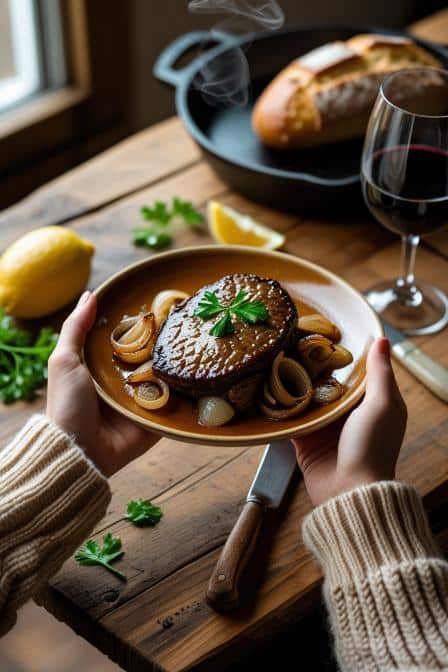Ever found yourself staring at a slab of beef liver and wondering how on earth to make it taste amazing? You’re not alone. Liver often gets a bad rap for its strong flavor and unique texture. But here’s a little secret from the kitchen: done right, beef liver can be a tender, rich, and downright delicious powerhouse meal. Plus, it’s one of the most nutrient-dense foods you’ll ever cook, packed with iron, vitamin A, and protein.
This article dives deep into simple beef liver recipes that anyone—even beginners—can master. We’ll explore why liver is so special, how to pick the best ingredients, step-by-step cooking guidance, the science behind the techniques, and perfect pairings. Stick with me, and you’ll go from wary to wow in no time.
Why Beef Liver? What Makes These Recipes Special
Beef liver is often overlooked because of its bold flavor and slightly grainy texture. But chefs and nutritionists alike know it’s a gem. Unlike other cuts, liver is an organ meat, rich in essential vitamins like B12 and folate, plus loads of iron. That makes it a favorite in traditional cuisines worldwide—from French pâtés to Indian fry-ups.
These simple recipes are designed to highlight the liver’s natural richness without overwhelming it. We’re talking quick marinades, smart searing, and clever pairings that balance flavor and texture. They’re practical for weeknights but sophisticated enough for impressing guests. No complicated prep or rare ingredients here—just straightforward, tasty dishes that respect the liver’s character.
Ingredients & Substitutions
When you cook liver, ingredient quality really shows. Freshness is king, since liver spoils fast and off-flavors develop quickly. Here’s what you’ll typically need:
| Ingredient | Purpose | Substitutions & Notes |
|---|---|---|
| Beef liver (fresh) | Main protein | Chicken or lamb liver (milder flavor) |
| All-purpose flour | Light dredge for crispness | Almond flour (gluten-free), chickpea flour |
| Garlic cloves | Flavor enhancer | Garlic powder (in a pinch) |
| Onion | Sweetness & texture | Shallots or leeks |
| Butter or oil | Cooking fat | Ghee (for nuttier taste), olive oil |
| Salt & black pepper | Seasoning | Sea salt, white pepper for milder heat |
| Fresh parsley | Garnish & freshness | Cilantro, chives |
| Lemon juice | Bright acidity | Vinegar (apple cider or white) |
| Milk or buttermilk | Soaking liquid (optional) | Yogurt or water (soak reduces bitterness) |
Ingredient Insights
- Fresh vs. Frozen Liver: Fresh liver gives you a tender bite and cleaner taste. Frozen can be used but thaw gently to avoid a mushy texture.
- Flour choice: Flour helps form a light crust when pan-fried. Gluten-free flours work but watch the texture; almond flour adds a nutty hint.
- Milk soak: Soaking liver in milk or buttermilk before cooking mellows bitterness and tenderizes slightly. It’s a classic technique that’s simple but effective.
- Fat for cooking: Butter adds richness and browns beautifully but burns easily; ghee or oil can tolerate higher heat for searing.
Step-by-Step Instructions for Classic Pan-Fried Beef Liver
- Prep the liver: Rinse the liver slices under cold water, pat dry with paper towels. If desired, soak in milk for 30 minutes to 1 hour to reduce the strong flavor.
- Dredge lightly: Mix salt, pepper, and flour on a plate. Lightly coat each liver slice, shaking off excess flour. This crust helps form a delicious, slightly crispy exterior.
- Heat the pan: Use a heavy skillet (cast iron is perfect). Melt butter or heat oil over medium-high heat until shimmering.
- Sear the liver: Place slices carefully in the pan. Cook for about 2 minutes per side. Don’t overcrowd the pan; this ensures even browning.
- Add onions and garlic: Push liver to the side, toss sliced onions and garlic in the pan, cooking until golden and soft. The sweet onion complements the liver’s richness.
- Finish and garnish: Squeeze fresh lemon juice over the liver, sprinkle chopped parsley, and serve immediately.
Expert Tips & Common Mistakes
- Don’t overcook! Liver gets tough and chalky if cooked past medium. Aim for a slightly pink center.
- Pat dry before dredging to avoid sogginess.
- High heat searing locks in juices, but avoid burning the butter—adjust heat as needed.
- Flip once; too much flipping breaks the delicate slices.
- For spicier touch, add a pinch of cayenne or smoked paprika to the flour mix.
Variations
- Swap out butter for bacon fat to add smoky depth.
- Add mushrooms sautéed with the onions for earthiness.
- Serve with mashed potatoes or creamy polenta for a hearty meal.
Cooking Techniques & Science
Why Searing Matters
Searing liver over high heat causes the Maillard reaction—the chemical process that browns proteins and sugars, creating those complex savory flavors. That crust acts as a flavor barrier, locking juices inside, which is crucial because liver can dry out fast.
The Science of Soaking
Liver contains some blood residues and natural enzymes that contribute to its bitter notes. Soaking in milk or buttermilk helps dilute and neutralize these compounds. It also softens the texture a bit, making the end product more tender and less metallic.
Storage & Reheating
Cooked liver is best eaten fresh but can be stored in airtight containers in the fridge for up to 2 days. Reheat gently over low heat or in a warm pan; microwave tends to toughen it. Avoid freezing cooked liver as the texture deteriorates.
Variations & Substitutions
For a gluten-free option, substitute flour with chickpea or rice flour. For dairy-free, use olive oil instead of butter and soak liver in water with a splash of lemon juice instead of milk. Vegetarians and vegans might explore mushroom or beet-based “liver” substitutes but that’s a different story.
Essential Tools
- Cast iron skillet is ideal for even heat distribution and perfect sear.
- A sharp chef’s knife makes precise liver slicing easy.
- Paper towels are essential for drying liver to ensure a crispy crust.
Serving & Pairing Suggestions
Beef liver pairs beautifully with creamy, buttery sides to balance its intensity. Think mashed potatoes whipped with cream, roasted root vegetables, or simple steamed greens like spinach. A drizzle of browned butter or caramelized onions adds sweetness and depth.
Drink Pairings
Liver’s robust flavor matches well with medium-bodied red wines like Pinot Noir or Merlot. For beer lovers, a malty brown ale or a slightly hoppy amber can cut through the richness. Non-alcoholic options include sparkling water with lemon or a tart cranberry juice.
Presentation Tips
Serve liver slices neatly arranged on a warm plate. Garnish with fresh herbs like parsley or chives to add color contrast. A wedge of lemon on the side brightens both flavor and visual appeal.
Best Time to Serve Beef Liver
Beef liver is traditionally considered a breakfast or brunch item in many cultures, especially when paired with onions and toast. It’s also perfect for a quick, nutrient-dense weeknight dinner. The iron boost is particularly welcomed during colder months or for those needing a dietary pick-me-up.
Conclusion
Beef liver is one of those misunderstood ingredients that deserves a second chance. Its nutritional profile is exceptional, and when cooked with care, it transforms into a tender, flavorful dish that’s easy to love. The key is fresh liver, simple seasoning, and attentive cooking—don’t overcook and don’t rush.
Soaking the liver, quick high-heat searing, and balancing with onions and acidity make these recipes stand out. Experiment with fats like butter or bacon drippings and sides that bring complementary textures. You’ll soon find this humble organ meat starring on your plate more often.
Try these simple beef liver recipes and enjoy a meal that’s rich in flavor, history, and nutrition.
FAQs About Simple Beef Liver Recipes
Q1: How do I know if my beef liver is fresh?
Fresh liver should have a deep reddish-brown color and a mild scent—not sour or ammonia-like. It should feel firm, moist, but not slimy.
Q2: Why does liver taste bitter sometimes?
Bitterness can come from blood residues or oxidation. Soaking liver in milk helps reduce this bitterness and mellows flavor.
Q3: Can I freeze fresh liver?
Yes, but freeze it as soon as possible after purchase. Thaw gently in the fridge to preserve texture.
Q4: What is the best way to cook liver for beginners?
Pan-frying slices after a brief milk soak is the simplest method. Keep cooking times short for tender results.
Q5: Are there any health concerns with eating liver?
Liver is nutrient-dense, but because of high vitamin A content, eating it excessively may cause hypervitaminosis A. Moderation is key.
If you’re ready to elevate this humble ingredient, these simple beef liver recipes offer an accessible yet professional approach. The techniques here can be adapted and expanded as you get comfortable, turning liver from a challenge into a kitchen favorite.

